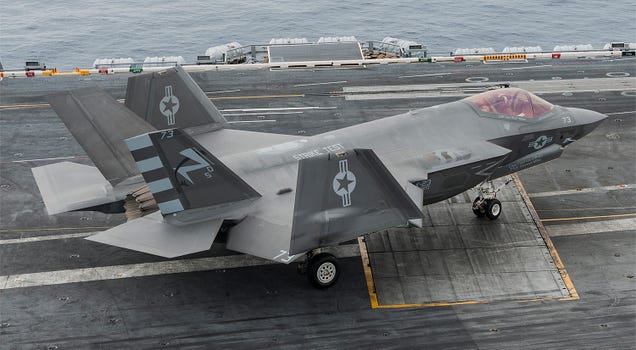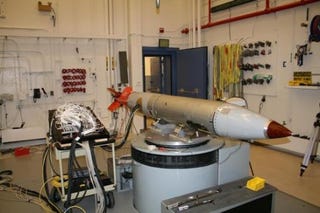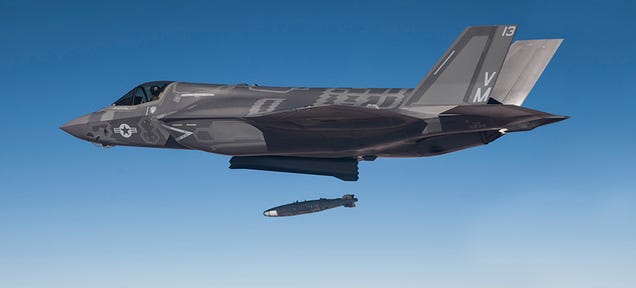The
Joint Strike Fighter has been flown in air-to-air combat maneuvers against
for the first time and, based on the results of these and earlier flight-envelope evaluations, test pilots say the aircraft can be cleared for greater agility as a growth option.
Although the F-35 is designed primarily for attack rather than air combat, U.S. Air Force and
test pilots say the availability of potential margin for additional maneuverability is a testament to the aircraft’s recently proven overall handling qualities and basic flying performance. “The door is open to provide a little more maneuverability,” says Lockheed Martin F-35 site lead test pilot David “Doc” Nelson.
The operational maneuvers were flown by Nelson in AF-2, the primary Flight Sciences loads and flutter evaluation aircraft, and one of nine F-35s used by the Edwards AFB-based 412th Test Wing for developmental testing (DT). The F-35 Integrated Test Force at Edwards has six F-35As, two F-35Bs and a single F-35C dedicated to DT work, as well as a further set of aircraft allotted to the Joint Operational Test Team. Work is underway as part of efforts to clear the final system development and demonstration (SDD) maneuvering envelopes on the way to initial operational capability (IOC). The U.S.
F-35B IOC is targeted for later this year, the Air Force’s F-35A in 2016, and the U.S. Navy’s F-35C in 2019.
“When we did the first dogfight in January, they said, ‘you have no limits,’” says Nelson. “It was loads monitoring, so they could tell if we ever broke something. It was a confidence builder for the rest of the fleet because there is no real difference structurally between AF-2 and the rest of the airplanes.” AF-2 was the first F-35 to be flown to 9g+ and -3g, and to roll at design-load factor. The aircraft, which was also the first Joint Strike Fighter to be intentionally flown in significant airframe buffet at all angles of attack, was calibrated for inflight loads measurements prior to ferrying to Edwards in 2010.
The operational maneuver tests were conducted to see “how it would look like against an F-16 in the airspace,” says Col. Rod “Trash” Cregier, F-35 program director. “It was an early look at any control laws that may need to be tweaked to enable it to fly better in future. You can definitely tweak it—that’s the option.”
“Pilots really like maneuverability, and the fact that the aircraft recovers so well from a departure allows us to say [to the designers of the flight control system laws], ‘you don’t have to clamp down so tight,’” says Nelson. Departure resistance was proven during high angle-of-attack (AOA) testing, which began in late 2012 with the aircraft pushing the nose to its production AOA limit of 50 deg. Subsequent AOA testing has pushed the aircraft beyond both the positive and negative maximum command limits, including intentionally putting the aircraft out of control in several configurations ranging from “clean” wings to tests with open weapons-bay doors. Testing eventually pushed the F-35 to a maximum of 110 deg. AOA.
An “aggressive and unique” approach has been taken to the high AOA, or “high alpha” testing, says Nelson. “Normally, test programs will inch up on max alpha, and on the
it took us 3-4 months to get to max alpha. On this jet, we did it in four days. We put a spin chute on the back, which is normal for this sort of program, and then we put the airplane out of control and took our hands off the controls to see if it came back. We actually tweaked the flight control system with an onboard flight test aid to allow it to go out of control, because it wouldn’t by itself. Then we drove the center of gravity back and made it the worst-case configuration on the outside with weapons bay doors and put the aircraft in a spin.” The aircraft has been put into spins with yaw rates up to 60 deg./sec., equal to a complete turn every 6 sec. “That’s pretty good. But we paddled off the flight-test aid and it recovered instantly,” he says.
Pilots also tested the ability of the F-35 to recover from a deep-stall in which it was pushed beyond the maximum AoA command limit by activating a manual pitch limiter (MPL) override similar to the alpha limiter in the F-16. “It’s not something an operational pilot would do, but the angle of attack went back and, with the center of gravity way back aft, it would not pitch over, but it would pitch up. So it got stuck at 60 or 70 deg. alpha, and it was as happy as could be. There was no pitching moment to worry about, and as soon as I let go of the MPL, it would come out,” Nelson says.
Following consistent recoveries, the test team opted to remove the spin chute for the rest of the test program. “The airplane, with no spin chute, had demonstrated the ability to recover from the worst-case departure, so we felt very confident, and that has been proven over months of high alpha testing,” says Nelson. “It also satisfied those at the Joint Program Office who said spin chute on the back is not production-representative and produces aerodynamic qualities that are not right.” Although there are additional test points ahead where the spin chute is scheduled to be reattached for departure resistance with various weapons loads, the test team is considering running through the points without it.
With the full flight envelope now opened to an altitude of 50,000 ft., speeds of Mach 1.6/700 KCAS and loads of 9g, test pilots also say improvements to the flight control system have rendered the transonic roll-off (TRO) issue tactically irrelevant. Highlighted as a “program concern” in the
’s Director of Operational Test and Evaluation (
&E) 2014 report, initial flight tests showed that all three F-35 variants experienced some form of wing drop in high-speed turns associated with asymmetrical movements of shock waves. However, TRO “has evolved into a non-factor,” says Nelson, who likens the effect to a momentary “tug” on one shoulder harness. “You have to pull high-g to even find it.” The roll-off phenomena exhibits itself as “less than 10 deg./sec. for a fraction of a second. We have been looking for a task it affects and we can’t find one.”













